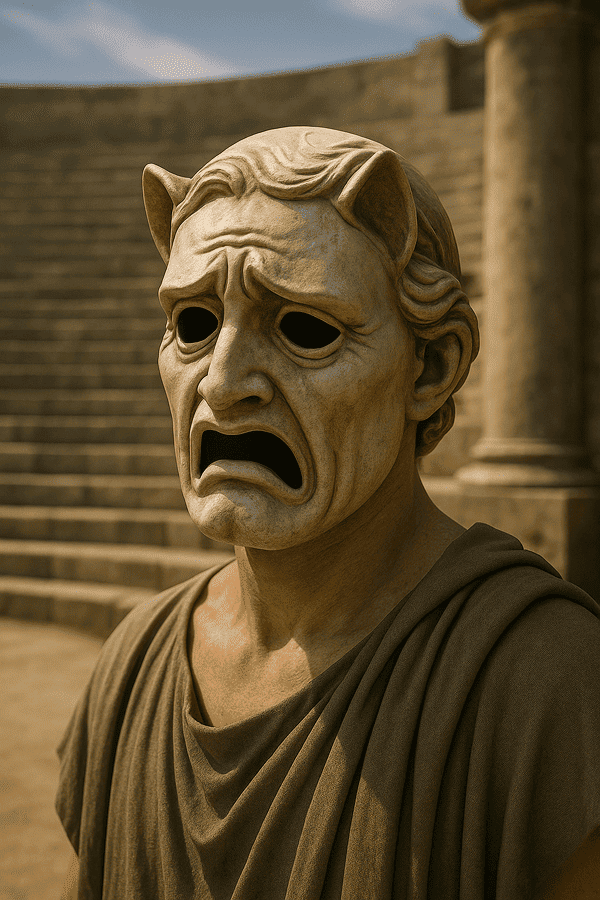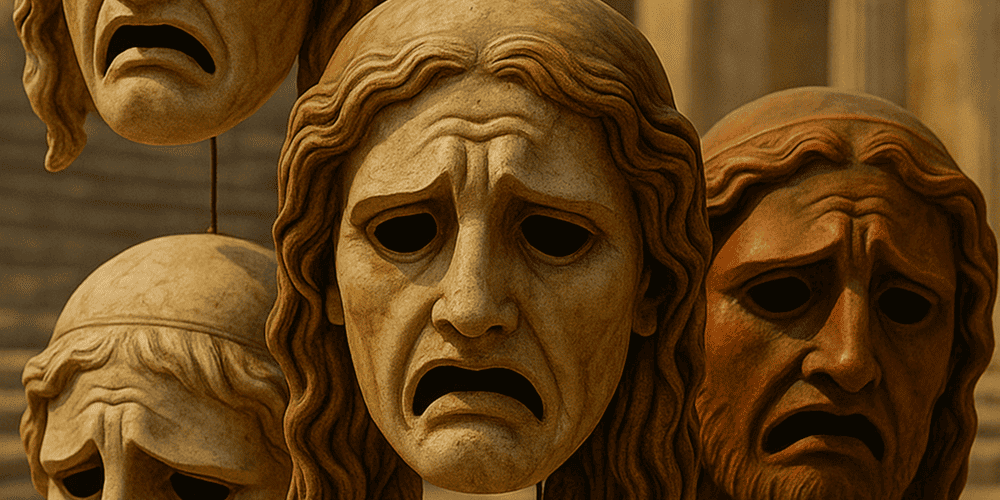Theatrical Tragedy Masks are among the most enduring and recognizable emblems of Western dramatic tradition, particularly rooted in ancient Greek theatre. Known for their solemn and expressive features, tragedy masks typically display downturned mouths, furrowed brows, and wide eyes — capturing the essence of suffering, sorrow, and human vulnerability. Traditionally, these masks were made large and stylized to be visible to audiences in vast amphitheaters, their exaggerated forms amplifying the emotional resonance of tragic stories. Although most closely associated with classical Greek culture, Theatrical Tragedy Masks have influenced performance art across Europe and beyond, serving as both practical performance tools and powerful cultural symbols since the 5th century BCE.
Historical Origins of Theatrical Tragedy Masks
The history of Theatrical Tragedy Masks begins in ancient Greece, where drama emerged from religious rituals honoring Dionysus, the god of wine, fertility, and transformation. The Greek word for mask, “prosopon” (πρόσωπον), means both “face” and “mask,” reflecting the transformation of the actor into a character. The tradition likely evolved from earlier Dionysian ceremonies, where worshippers donned animal skins and primitive masks. By the 6th century BCE, as theatre matured in Athens, masks became central to formal tragedies written by playwrights like Aeschylus, Sophocles, and Euripides. Early masks were crafted from lightweight organic materials — linen, wood, leather, or cork — molded to fit the actor’s face and painted to convey age, gender, and emotion. Over time, the design of tragedy masks evolved from simple, abstract forms to more naturalistic and expressive visages, adapting to advancements in stagecraft and audience expectations. Significant archaeological finds, such as terracotta mask miniatures and depictions on ancient vases, provide insight into their appearance and use. The contrasting Comedy Masks, with their joyful expressions, were developed alongside tragedy masks to represent the dual nature of dramatic art.
Cultural Significance and Symbolism of Theatrical Tragedy Masks
Theatrical Tragedy Masks hold profound symbolic meaning within their native culture. In ancient Greece, they were believed to serve as a bridge between the mortal and divine realms, allowing actors to channel not just characters but also archetypal human experiences of loss, fate, and catharsis. The mask’s somber expression and exaggerated features enabled actors to convey intense emotion, even in the back rows of enormous open-air theaters. Tragedy masks also represented the themes of fate and the inevitability of suffering, central to Greek tragic philosophy. In religious terms, the mask was thought to temporarily erase the actor’s identity, permitting the spirit of the character — or even a god — to inhabit the performer. Myths and legends, such as those of Dionysus and the origins of drama, are closely linked to the mask’s symbolic power. Socially, the use of masks leveled distinctions between individuals, emphasizing the collective experience of the audience and the universality of tragic themes.

Materials and Craft Techniques of Theatrical Tragedy Masks
Traditional tragedy masks were crafted from lightweight, flexible materials such as linen, leather, cork, or wood, chosen for comfort and ease of use. The process began with shaping the material over a mold or wooden form, then allowing it to harden before painting and decorating. Artisans would sculpt expressive features — deep-set eyes, furrowed brows, pronounced noses, and downturned mouths — to project emotion across large spaces. Natural pigments, charcoal, and ochre were used for coloring, while hair, beards, or headdresses could be attached for specific roles. Some masks included an open mouth to amplify the actor’s voice. Regional differences existed: Athenian masks were often more naturalistic, while those from southern Italy or later Roman theater might be more stylized. Color held meaning — pale for women, dark for men, gold or black for gods or spirits. Although few original masks survive due to their perishable materials, ancient depictions and surviving miniatures offer clues about their construction and decoration.
Functions and Uses of Theatrical Tragedy Masks
The primary function of Theatrical Tragedy Masks was to enable actors to portray multiple roles, genders, and ages while projecting emotion to large audiences. Their use was essential in Greek tragedy, where a handful of actors played all the roles, supported by a masked chorus. Masks allowed for rapid character changes, vocal projection, and the suspension of disbelief. In addition to their theatrical purpose, tragedy masks played a role in religious festivals, processions, and rites dedicated to Dionysus. With the spread of Greek theater to Rome and beyond, the tradition of tragedy masks was adapted and preserved, influencing medieval mystery plays, Renaissance theatre, and even modern performance. Today, tragedy masks are used in educational settings, historical reenactments, and as universal symbols of the dramatic arts.
Regional Variations of Theatrical Tragedy Masks
While Athens was the epicenter of Greek tragedy, regional variations flourished across the Hellenic world. In Magna Graecia (southern Italy), Greek colonies developed their own mask styles, sometimes blending local artistic conventions with classical forms. Roman tragedy masks, inspired by Greek models, were often more ornate and included additional colors or metallic accents. Over centuries, the tragedy mask tradition influenced Italian commedia dell’arte, French neoclassical theatre, and modern European drama, each adapting the mask to their own purposes. Comparisons with Asian mask traditions, such as Japanese Noh or Indian Kathakali, reveal both shared and unique approaches to expressing emotion and identity through masks.
Famous Examples and Collections of Theatrical Tragedy Masks
Many of the most significant representations of Theatrical Tragedy Masks are found in ancient art: terracotta mask miniatures, marble reliefs, and painted pottery from Greece and Rome. Actual masks, due to their organic materials, rarely survive, but famous examples can be seen in the National Archaeological Museum of Athens, the British Museum, and the Louvre, which display ancient mask depictions and related theatrical artifacts. The Getty Villa (Los Angeles) and the Metropolitan Museum of Art (New York) also feature notable collections of Greek and Roman theater art. Private collections and digital archives, such as those on toddmasks.com, offer access to rare images, scholarly commentary, and virtual reconstructions of tragedy masks.
Influence of Theatrical Tragedy Masks on Art and Culture
The image of the Tragedy Mask has become a universal symbol of drama, often paired with the Comedy Mask to represent the full spectrum of theatrical art. These masks appear on theater logos, award statues, and in countless paintings, sculptures, and graphic designs. Their influence extends to literature, film, and music — often used to evoke themes of fate, emotion, and catharsis. In fashion and modern design, the tragedy mask motif is frequently reinterpreted as a symbol of sophistication or introspection. The preservation and continued use of tragedy masks in theater education, public art, and festival culture underscore their enduring role in world heritage.

Contemporary Status and Preservation of Theatrical Tragedy Mask Traditions
While the original Greek tradition of mask-making has faded, the practice is preserved through academic study, museum curation, and theatrical innovation. Modern artisans and theater companies create replica tragedy masks using historical techniques for use in classical play revivals, educational programs, and cultural festivals. Workshops and masterclasses — some featured on toddmasks.com — help transmit mask-making skills and dramatic interpretation to new generations. Digital resources, museum exhibitions, and interdisciplinary research ensure that the artistry, symbolism, and performance practice of tragedy masks remain vibrant in the twenty-first century.
Collecting and Acquiring Theatrical Tragedy Masks
Collecting authentic ancient tragedy masks is nearly impossible due to their rarity, but high-quality replicas and educational models are widely available from artisan workshops, museum shops, and online retailers. Prices vary depending on craftsmanship, material, and provenance. Collectors are encouraged to seek expert advice, prioritize ethical sources, and support educational or artistic initiatives. Toddmasks.com provides guidance on identifying quality replicas, understanding historical significance, and practicing responsible collecting. Ethical considerations are important, especially for objects with sacred or cultural value.
